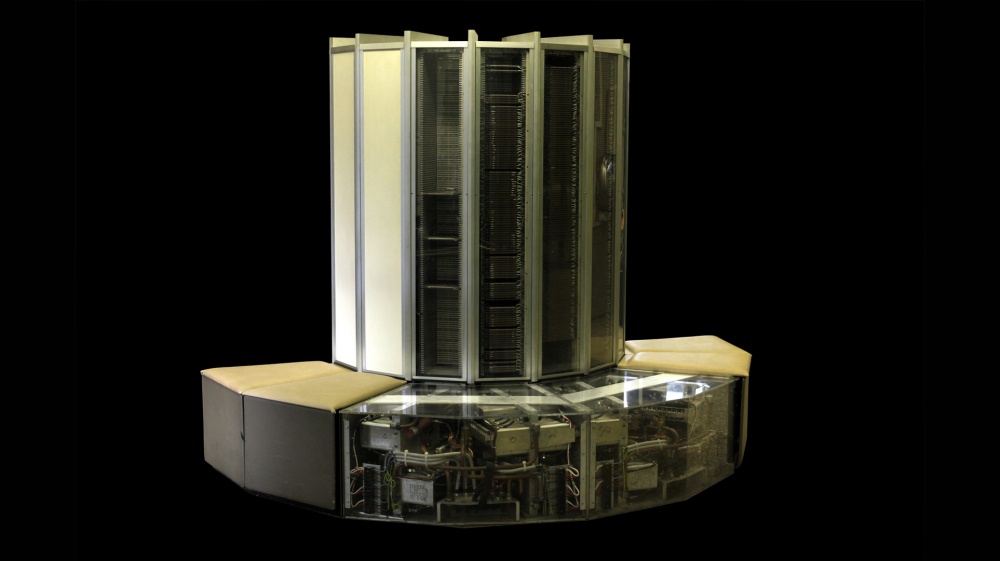This picture from Supertietokone, joka toimi myös sohvana article shows the classic Cray supercomputer from the 1970s and 1980s, which was specially designed – as Cray computers have always been.
It does not a traditional computer, but as a strange seat. And you can really sit on one of those if you get access to a one. I have sit on one one Cray supercomputer in Finland.
The Cray-1 was a supercomputer designed, manufactured and marketed by Cray Research. Announced in 1975 and it represented the pinnacle of its time. The Cray-1 was the first supercomputer to successfully implement the vector processor design. “In 1978, the Cray-1 supercomputer cost $7 million, weighed 10,500 pounds and had a 115 kilowatt power supply. It was, by far, the fastest computer in the world” . The clock frequency was first 80 MHz.
The 160 MFLOPS Cray-1 was succeeded in 1982 by the 800 MFLOPS Cray X-MP, the first Cray multi-processing computer. Finland got it’s Cray XM-P supercomputer in early 1990′s.
Comparing the 1970’s Cray-1 supercomputer against the Raspberry Pi single-board computer range #RaspberryPi @hacksterio
https://blog.adafruit.com/2024/01/17/comparing-the-1970s-cray-1-supercomputer-against-the-raspberry-pi-single-board-computer-range-raspberrypi-hacksterio/
“In 1978, the Cray-1 supercomputer cost $7 million, weighed 10,500 pounds and had a 115 kilowatt power supply. It was, by far, the fastest computer in the world,” Longbottom writes of the device, designed as the flagship product of Seymour Cray’s high-performance computing company. “The Raspberry Pi costs around $70 (CPU board, case, power supply, SD Card), weighs a few ounces, uses a five watt power supply and is more than 4.5 times faster than the Cray 1.”


4 Comments
Tomi Engdahl says:
Cray 1 – The maximum possible hardware performance was said to be 160 MFLOPS for the 80 MHz Cray 1, comprising linked multiply and add, for two results per clock cycle. The LLL benchmark maximum shown is 82.1 MFLOPS with average 11.9 and minimum 1.2. Then Linpack and Whetstone are 27 and 6 MFLOPS, Linpack benefiting from linked multiply and add.
http://www.roylongbottom.org.uk/Cray%201%20Supercomputer%20Performance%20Comparisons%20With%20Home%20Computers%20Phones%20and%20Tablets.htm
Tomi Engdahl says:
Marc Dufour
“The Raspberry Pi costs around $70 (CPU board, case, power supply, SD Card), weighs a few ounces, uses a five watt power supply and is more than 4.5 times faster than the Cray 1.”
https://blog.adafruit.com/2024/01/17/comparing-the-1970s-cray-1-supercomputer-against-the-raspberry-pi-single-board-computer-range-raspberrypi-hacksterio/
wink apk says:
The Raspberry Pi, including the CPU board, case, power supply, and SD Card, totals approximately $70. It’s lightweight, weighing just a few ounces, and operates with a five-watt power supply. Remarkably, it’s over 4.5 times faster than the Cray 1.
Tomi Engdahl says:
Comparing the 1970’s Cray-1 supercomputer against the Raspberry Pi single-board computer range #RaspberryPi @hacksterio
https://blog.adafruit.com/2024/01/17/comparing-the-1970s-cray-1-supercomputer-against-the-raspberry-pi-single-board-computer-range-raspberrypi-hacksterio/